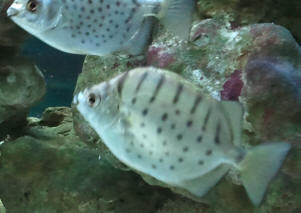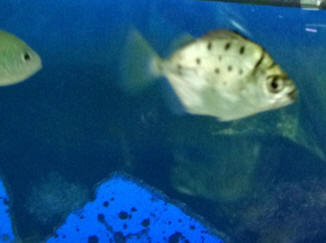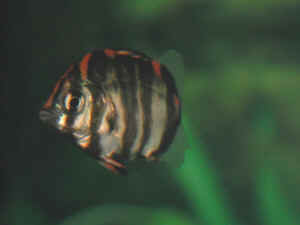|
FAQs on Scats, Family Scatophagidae,
Identification
Related Articles: Scats, Scats and monos;
Old favourites and new species for the brackish
water aquarium by Neale Monks,
Related FAQs: Scats 1,
Scats 2, Scat
Behavior, Scat Compatibility,
Scat Selection, Scat Systems, Scat
Feeding, Scat Disease, Scat Reproduction,
|

|
|
Selenotoca identification help 1/3/17
Good day,
<Morning, Joel!>
A friend showed me a picture she took at a LFS some time back and what caught my
eye was a marine tank which included Monodactylus spp. and Selenotoca spp.
alongside damsels and other assorted marine fish.
<Indeed.>
I originally identified the scat as the more common Silver Scat (S.
multifasciata) but I've never seen one at that size with so few bands and spots.
Is it possible that this was a Moon Scat (S. papuensis)? I've read elsewhere on
WWM that size of spots is the defining characteristic, vice number of spots, and
the smaller size supports my original identification. Google has offered no help
with pictures for S. papuensis. I would greatly appreciate your thoughts on this
subject. Sorry for the blurry picture, hopefully it is clear enough to make an
educated guess.
<It is indeed.>
Thank you again,
Joel
<Probably Selenotoca multifasciata. I've yet to see convincing Selenotoca
papuensis in the aquarium trade. Some authorities maintain they are the same
fish. Hard to know for sure. Variations in spots and stripes are common among
Selenotoca multifasciata, making visual inspection an unreliable (probably
useless) way to tell the two species of Selenotoca apart. Frustratingly, while
scientific references (and Aqualog) refer to the key difference between the two
species being the number of dorsal fin spines, nothing available freely online
actually says what this difference is! Nor does my Aqualog book. Fishbase is
useless on this species, too. So for now, I'm stuck with using Sterba's
'Freshwater Fishes of the World'.
His drawings of the two Selenotoca species shows them nearly identical in
appearance, except that the bands and spots are much thicker and bolder, more
like Tiger Barb markings than a typical Silver Scat. With all this said, your
specimen is certainly unusual, I simply feel that it's within the range of
variation among Selenotoca multifasciata. Sorry I can't be
more certain or helpful; Maurice Kottelat is really the chap you want to get in
touch with. Cheers, Neale.>
|
 |
|
Fish Identification 8/3/11
Hi guys!
<And gals...>
I'm asking a question for the first time but have learned
tonnes from WWM. Thanks for that! I have a well established 80
gallon marine tank thanks to you!
Can you please help me identify the fish in the attachment? My
LFS said it was a Silver Cod then I thought it must be a grouper
since they swim together but Googled a lot but no luck.
Thanks! :D
<This/these are Selenotoca multifasciata. Bob Fenner>
|
|

|
Scatophagus species Hi, I caught a school of
scats in a mouth of a freshwater stream in Bintan Island, Indonesia.
They have an orange base and broad black stripes. They change colour
constantly, so that they sometimes become totally black except for the
orange at the top. What specie of scat do you figure this to be. /JJ
<I'll be... have never seen the species but it does sound like
Scatophagus tetracanthus. Please see the description here: http://www.wetwebmedia.com/Scatart.htm
or plug the name into your search engines or fishbase.org. Bob
Fenner>
Re: Scatophagus species Dear Bob, Thanks. I
found a picture of the tetracanthus at http://www.ohiexchange.com/armke/images/scatophagus_tetracanthus.jpg
<Ah yes> I think I may have juveniles (1 inch) of this specie.
There is a hint of the orange at the dorsal edge of the scats in the
picture. Perhaps the orange disappears as the scat mature. <Yes,
unfortunately> Indeed when I made a closer examination of what I
have, I notice that interspersing the vertical band is not quite orange
but yellow-tint silver. Maybe I'll send a picture when I can borrow
w a digital camera. /JJ <Very good. Will post. Bob
Fenner>
Re: Scatophagus species Dear Bob, As
promise I am attaching a photo... <Very nice> This is not a
very good photo as the camera ran out of battery before we could
get a good shot. Nevertheless you can get an idea from it. I had
wanted to get a picture of the scats when they turn completely
black except for the orange on the dorsal edge, but that will have
to wait. <Have seen this... esp. on S. argus (here), when
"bummed"... due to water quality, nutrition, social
issues> Also, now that the scats have grown a little larger, I
am also beginning to doubt of they are tetracanthus! The stripes
are not as broad, and in fact the older ones are beginning to have
spots appearing (though I know they are not argus because I caught
juvenile arguses before). <This is assuredly argus> Would be
glad for identification. /JJ
<Bob Fenner, just back from Hawai'i> |
|

|
| Re: Scatophagus species Hmm... I found a
photo in LiveAquaria.com which has Ruby Scats as Scatophagus Argus,
the picture of the scat does resemble what I have. But I once
caught green spotted scats which I assumed to be the Argus. Do
Argus juveniles have different appearances? I'm a little
confused. <Mmm, please see here: http://www.wetwebmedia.com/Scatart.htm
These are the same species. Bob Fenner> /JJ |
|
Help with Identification -- 10/09/07 Hello Crew, First I
would like to thank you guys for providing us novices with a
great deal of help and advice. I'm learning all the time.
<Hello, and thanks for the nice words.> I recently moved
into a house in Thailand and inherited a reef tank which was left
by the previous occupant (who left in a rush to Germany
apparently). The landlord informed me that the tank had been left
untouched for a couple of weeks and has given it to me. When I
turned the power on I was shocked to see that all of the
occupants were still alive (skinny but alive) including a few
nice corals (red leather finger, daisy polyps and star polyps).
After spending most of the past couple weeks on your site and
goggle images I have managed to identify most of the live
critters I have to 3" tang, royal Gramma, 2 2" false
percula clown fish, 4" lawnmower blenny, 2" yellow
watchman goby, 1 coral brand shrimp, 1 skunk shrimp, 6 blue leg
hermit and 3 turbo snails. I would be very great full if you
could help identify the attached fish. I have two in the tank, I
have searched but have been unable to find anything close.
They're small, copper with black spots and very very quick
swimmers. <Picture too small, but they look like Scatophagus
species of some sort. The body shape and the distribution of the
fins looks about right. Scatophagus are euryhaline marine fish
that swim in and out of freshwater rivers throughout their life.
They are extremely hardy. Basically omnivorous. Not sure
they're typically classed as "reef safe" fishes,
since they'll eat anything they can cram into their mouths,
but they won't harm sessile invertebrates or armoured things
like snails and shrimps.> Since I made a water change,
something as appeared on the glass in 2 places. It looks like
they could be eggs of some kind?? (see attached photo) There are
small rows of white dots, similar in shape to a finger print.
Could you possibly identify these?? good or bad?? <Too small
for me to identify. Need a bigger picture. Aim for a photo around
600 pixels across.> The tank is 75 gallons, wet/dry filter, 4
pumps, protein skimmer (unknown, no brand or labels), lots of
live rock, 1.5" crushed coral substrate, Salinity is 1.05,
ph is 8.4, temp 79-81 degrees, nitrate >10, NHO3 =0, 150 watt
metal halide lighting with 20,000k light. <SG is 1.05? That
can't be right. Do you mean SG 1.025?> Sorry for the
length of this email, I hope I've not bored you to sleep!
<Nope. Thanks for writing.> Any advice is greatly
appreciated Thanks Tony
Re: Help with Identification -- 10/09/07 Thank you for
the quick response, I've attached another photo, the round
white dots are very small and its difficult to pick up on the
photo. If you can't identify it would it be better to just
remove them? Better safe than sorry?? Just one more question,
with a 75 gallon tank how much daily water evaporation would you
expect, it seems I have to top up around half a liter a day is
this normal? Thanks again P.S. Yes the salt is 1.025 !!
<Hmm... very interesting. The pattern is odd, and reminds me
more of fish eggs than, say, snail eggs. Snails tend to deposit
their eggs in masses well after each partner has fertilised the
other (snails being, largely, hermaphrodites); but fish lay them
in rows, because they glide along the flat surface, the male
following the female fertilising them. So I'd be tempted to
leave them in place and see what happens. You could try and roll
them off the glass into a floating breeding trap or something, if
you were really worried. That works with some fish eggs quite
well. If they are fish eggs, they should obviously have a
developing embryo inside them. I may be barking completely up the
wrong tree here of course, in which someone else at WWM will see
the photos and tell us what they might be. There's no
"normal" rate of evaporation: it depends on air
movement, air temperature, air pressure, ambient humidity,
movement of the water, and all sorts of other factors. In other
words, "it is what it is" and all you can do is top up
the water loss each day (or however often you do it). Were the
two little fish Scats? Cheers, Neale>
Re: Help with Identification -- 10/09/07 Thank you
again Neale, The two fish were indeed scats, of the spotted
variety.... was just reading up on them it seems they're a
much more popular fresh water fish than marine fish which I guess
is why I couldn't find any info on them as I was looking in
the wrong place! <They are really only temporary residents in
freshwater, and ironically do much better in marine tanks than
freshwater ones, despite being sold as freshwater fish. Enjoy
they; they're lovely fish, and so long as they get lots of
bulky plant foods, they'll be happy. Basically treat like a
tang.> As for the maybe fish eggs, being a bit of a pessimist
I was a little worried that they may be parasites of some kind as
I could find nothing similar on the web. <Unlikely to be
parasites. Parasites don't leave their eggs in the open
(you've been watching too much 'Alien'!). Parasites
tend to put their eggs inside something a host will eat, such as
a smaller prey animal. So you can basically write off the idea
these are parasites.> I will keep a look out on your site to
see if anybody can identify them. I will leave them where they
are for now and see what happens. <Indeed.> Thanks for your
time, let me know if you ever come to Bangkok and I will buy you
a beer :) <Hah!>
Kind regards
<Cheers, Neale>
|
|
  
|
|
|

